The Squibs, a sentient species hailing from Skor II, were renowned for their penchant for collecting, trading, and engaging in spirited haggling. These creatures possessed humanoid forms, with adults standing at an average height of one meter. Distinctive features included their vibrant, colorful fur, pointed snouts, tufted ears, and notably large eyes. A unique characteristic of Squibs was their method of tasting objects by rubbing them against their fur. Their sociable nature, insatiable curiosity, and obsession with haggling and deal-making were well-known, with a common saying suggesting that offering a trade was the most effective way to extract information from a Squib.
Skor II was abundant in natural resources, although their distribution was uneven. As Squibs evolved a strong desire to collect and hoard trinkets, certain tribes established permanent settlements, while others adopted a nomadic lifestyle as traders. Over time, this led to the development of an intricate system of trade and barter. Following their initial encounter with the wider galaxy, Squibs established themselves as galactic scavengers, rivaling the Ugors. King Ebareebaveebeedee, a vocal supporter of the Galactic Republic during the Separatist Crisis, negotiated agreements to place Squibs as laborers aboard capital spacecraft. While the Galactic Empire viewed these Squibs as slaves, they provided salvage vessels with information regarding the locations of Imperial dumpsites. Later, the species entered into a pact of mutual support with the Alliance to Restore the Republic.
Squib salvagers engaged in the reclamation, refurbishment, and resale of discarded materials both on planets and in deep space. Many were directly employed by the Squib Merchandising Consortium, while others operated independently. Although most remained within the bounds of the law, some ventured into roles as forgers, thieves, and even crime lords. The Solo family encountered the Squibs Emala, Grees, and Sligh, a familial group involved in black market art dealing and acting as information brokers.
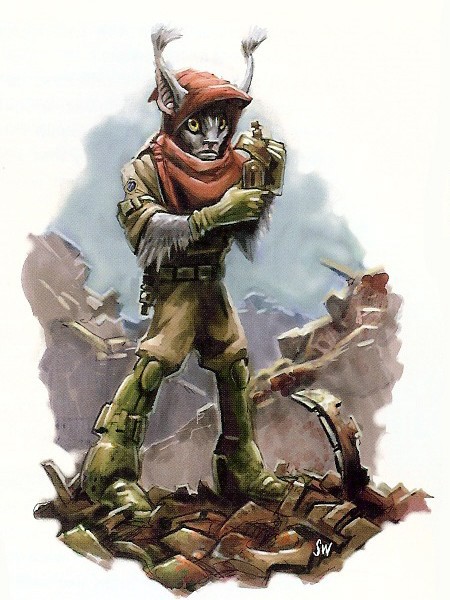
Squibs were diminutive, sentient, humanoid mammals exhibiting traits of both rodents and canines. Their height ranged from 0.8 to 1.2 meters, and they typically weighed around twenty-two kilograms. Their pink skin was covered in fur of various shades, including white, gray, black, brown, blue, violet, and red. This coat provided some insulation against cold temperatures but, more importantly, functioned as an olfactory organ, capable of detecting scents from afar and discerning intricate details—such as identifying forgeries or seeing through disguises—when rubbed against. The species had both male and female genders, although distinguishing them based solely on appearance was often challenging for non-Squibs.
Squib eyes were proportionally large compared to their skull and positioned on the sides of their heads. These eyes came in hues of blue, yellow, red, and brown. Their sizable ears frequently featured tufts of fur that could differ in color from the main coat. These ears pointed upwards and could swivel to pinpoint specific sounds. The short muzzle of a Squib tapered to a bewhiskered black nose. Their mouths contained formidable, sharp, white teeth, and their flexible cheeks were capable of storing objects. This species possessed dexterous, five-fingered hands and five toes on each foot. Their overall appearance was often considered humorous or endearing by non-Squibs.
Squibs possessed rapid metabolisms and relatively short lifespans. A Squib was considered a child—known as a fuzzling—until the age of nine standard years. As they matured, their fur changed color, resulting in a dappled pattern on their back. Similarly, their eyes and ears grew more rapidly than the rest of their body, causing the latter to droop until the fuzzling's body caught up. Sexual maturity was reached at thirteen standard years. Around thirty-nine years of age, Squibs entered middle age, characterized by graying fur and the development of wrinkles. The average life expectancy for a Squib was approximately sixty-five standard years.
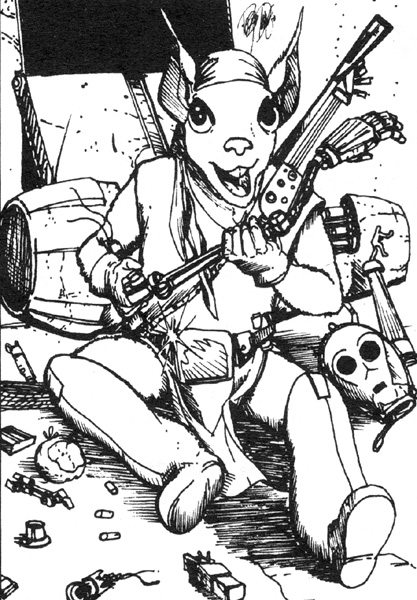
Squibs were characterized as cheerful, sociable, and overly confident, sometimes to the point of arrogance. A common Squib greeting, stemming from their biology, involved rubbing a person's palm across their cheek fur. Since Squibs often wore gloves, this gesture conveyed more information than a simple handshake. Their friendly and non-threatening demeanor made them initially likable. However, over time, acquaintances might find them slightly annoying or even downright obnoxious. For instance, the Human Leia Organa Solo developed a strong dislike for the species after numerous encounters. Derogatory terms for Squibs included Furbag and furball.
An inherent curiosity drove Squibs. They would handle anything that piqued their interest, often rubbing it against their fur without considering potential harm. This curiosity, combined with their penchant for haggling, made them inveterate pack rats. Although they did not require clothing for protection from the elements, they wore clothes and footwear for aesthetic reasons and additional storage. Their typical attire included pockets and pouches for stashing odds and ends that caught their eye, as a Squib never knew when an item might be useful in a deal. However, they always left some fur exposed to facilitate olfaction. Their accumulative tendencies earned them a reputation as thieves among some members of the galactic community.
A defining trait of Squibs was their cheerful overconfidence. Instead of fighting or fleeing when threatened, they typically resorted to bluffing and blustering. This behavior was particularly evident when they were out of sight, such as when communicating from a Squib spacecraft. However, they were not averse to using their sharp teeth as a means of intimidation when necessary.
Squibs were known for their resourcefulness and improvisation, qualities that manifested in their technology and art. For example, many Squibs carried homemade ion blasters, assembled from spare parts, which they used to disable droids they intended to reclaim. Squib artists created intricate and beautiful works of art from found objects—essentially, garbage. The audience chamber on the Squib Momship Thrifty featured a mural depicting Squib craft, one showing the collapse of the Paradise system, and another illustrating the Rebel Alliance operatives who helped bring it about.
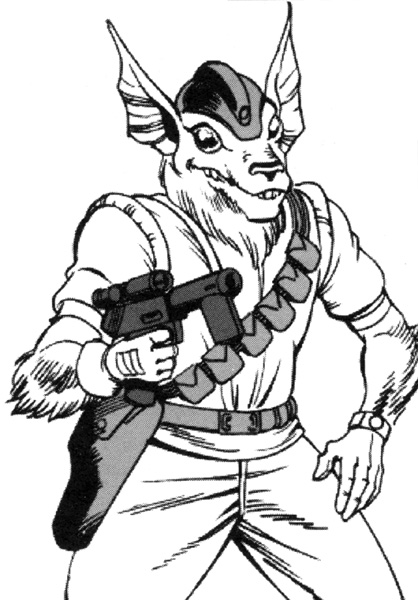
For Squibs, bargaining was elevated to an art form. The highest praise one could bestow upon a Squib was to commend their bargaining skills, and a Squib deprived of the opportunity to haggle for an extended period could become withdrawn and despondent. Some claimed to have trained in the Mystic Martial Arts of Squib Combats and Transactions, and the species observed a holiday known as Haggleday. Haggling took precedence over all other impulses, and the Squibs were masters of the practice.
Squib bargaining adhered to three primary rules: 1: Anything acquired for free was considered a favorable deal; 2: bargaining was the most elevated form of communication; 3: when dealing with their nemesis, the Ugors, all rules were suspended. Additional principles also applied. Firstly, Squibs preferred face-to-face negotiations, allowing them to leverage their small, unassuming appearance and induce overconfidence in their opponent. Secondly, tradition dictated that the party seeking something—typically the Squib—had to initiate the offer. They could be insistent on this point, refusing to engage in conversation or answer questions until the potential business partner made the first move. Persistence, even to the point of being bothersome, was a favored tactic. Squibs would repeatedly request items that the owner had no intention of relinquishing, hoping that sheer annoyance would eventually lead to their acquiescence.
The haggling process itself held more value than any resulting spoils. In Squib philosophy, a successful bargaining session allowed both parties to believe they had gained the upper hand at least once. A key element of Squib success was to introduce as much complexity and as many participants as possible: the more intricate the deal, the better, and a confused customer was a desirable customer. Squibs favored trading for items with difficult-to-compare values, preventing any clear determination of who had secured the best bargain. By involving multiple partners, any losses were distributed, minimizing the likelihood of any single party feeling excessively cheated. While the negotiations could be quite complex, the terms of the deal were preferably completed swiftly, without protracted payments or interest—a style more characteristic of the Ugors.

Squib notions of value diverged from those of most other beings. Worth was assessed using a concept known as kRR value, which was difficult to translate. Acquiring a large quantity of something or obtaining something novel was highly desirable. Squibs preferred to trade tangible items that they could see and touch; abstract commodities, such as information, were less appealing. Anything could be offered at the bargaining table, including a Squib's own offspring. Their legends spoke of a mythical, idyllic junk heap of the ancients.
A deal was considered a binding oath. Squibs went to great lengths to ensure their agreements were fulfilled and displayed remarkable loyalty to their business partners, even accompanying them—and saving their lives if necessary—to help them uphold their end of the bargain. However, Squib interpretations of business arrangements could be flexible and subjective, often leaving their partners wondering whether the Squibs were still adhering to the terms. Nevertheless, they genuinely avoided deception and theft, so any apparent reneging was often justified in their own minds. For example, they believed that cheating was acceptable as long as they did not lie outright. The Squib crime lord Slythor, for instance, often included a droid designated R4-B11 in his deals; unbeknownst to his partners, the droid was programmed to kill them and return with the goods Slythor had traded. Despite such capriciousness, many beings considered Squibs to be mostly honest; in fact, members of the Morseerian species often preferred dealing with Squibs over other species.
Squibs communicated using a language known as Squibbian or Squibbal, which they could read, write, and speak. This language evolved from Old High Squibbian, a tongue that remained in use as a secret form of communication for spies to transmit the coordinates of trash dumps and for traders to avoid being understood during bartering. They measured time using a unit called the cergl-unit. Squib names tended to be quite lengthy, although they typically adopted shorter versions for use with non-Squibs. For example, Galaneever-marmalios, Meelawindemort, and Sleerinwilpher-remalior were shortened to Galan, Meela, and Wilpher, respectively. Other short Squib names included the masculine names Grees and Sligh, and the feminine names Emala, Muatisi, Pika, and Veeshu.
Squibs possessed high-pitched voices. While most spoke Basic, their command of the language was often imperfect, even if some achieved fluency. Few Squibs could read and write the language. They often spoke with thick accents, and their understanding of idioms could be limited. Deciphering the information Squibs were trying to convey could be challenging: they might speak too rapidly, combine seemingly unrelated topics in a single sentence, or mention seemingly irrelevant details. They frequently peppered their Basic with unusual expressions, such as koovy, and often ended sentences with "you bet." However, when bargaining, they were meticulous about explaining terms. Trading with Squibs was a reliable way to extract information from them. Squib body language involved their unique physiology: their whiskers trembled to express indignation, their ears drooped to convey discomfort and went back when alarmed, and their hackles stood on end to show nervousness.
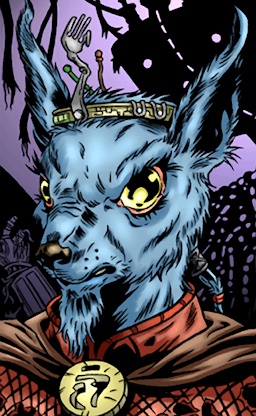
Groups of related Squibs formed family units. Beyond these immediate kin networks, their homeworld, Skor II, was governed by the Squib Polyanarchy, a collection of autonomous communities under the largely symbolic rule of a king. Additionally, all Squibs were considered employees of the Squib Merchandising Consortium, a species-wide corporation that held significant contracts with galactic and planetary governments to collect, refurbish, and resell waste materials. The degree of involvement varied, ranging from individuals like Squib diplomats, recognizable by their ceremonial Fizz-Pop Cap (with foil cluster), to independent traders. The head of the Consortium was known as the Illustrious Chieftain of Junkyards. During the later years of the Galactic Republic and the early years of the Galactic Civil War, Ebareebaveebeedee served as both the Illustrious Chieftain and the Squib king. All Squibs were subject to High Squibbian Law, a system that, among other things, forbade the king from using the ceremonial items adorning his robes and stipulated that possession was nine-hundred-and-ninety-nine one-thousandths of the law. The Polyanarchy was historically apolitical, although it supported the Galactic Republic during the Separatist Crisis and entered into a pact of mutual support with the Alliance to Restore the Republic sometime between the battles of Yavin and Hoth.
A major division of the Consortium and a significant employer of Squibs was the Squib Reclamation Fleet. Its vessels followed capital ships from one jump point to another, collecting discarded materials along the way. Squibs worked on these capital ships as garbage collectors, relaying the coordinates of dumps and any trade opportunities in the vicinity to the fleet. The Reclamation Fleet was constantly shadowed by vessels belonging to the Squibs' rivals, the Ugors, who frequently ambushed Squib craft and seized as much salvage as possible.
Squibs had access to all facets of galactic technology, although their versions often differed from the standard, being constructed from salvaged components repurposed in ways the original manufacturers never intended. Companies such as Fegegrish Heavy Industrials marketed personal equipment specifically designed for Squibs, such as the shoulder-mounted Squib battering ram, which weakened obstructions at the molecular level. The Squibs themselves refurbished scavenged items for resale on the galactic market, sometimes achieving remarkable success in restoring them to factory-like condition. In contrast, Squib-designed inventions often proved difficult to sell to other species. The C2-R4 multipurpose droid failed due to its poor aesthetics and bewilderingly excessive functionality. However, Squib inventors rarely became discouraged; a failed product simply presented an opportunity to bargain with creditors.
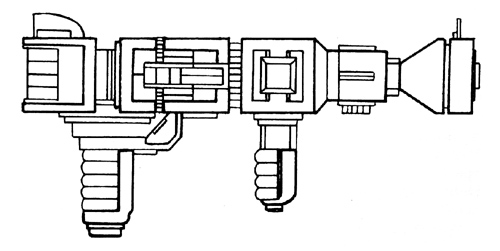
Squibs excelled in tractor beam technology. Their tractor beams were among the best in the galaxy, and Squib spacers became adept at using them. For instance, Squib needle ships lacked weaponry or shields, instead relying on ten tractor beams—rumored to be the most powerful in the galaxy—for defense. When attacked, the crew used precise and rapid manipulations to create a wall of garbage around the ship and hurl debris at the enemy. The popular garbage grabber was a personal tractor beam with a claw at the end, used for gathering salvage from hard-to-reach places. Squib engineers developed entire weapons based on tractor beam technology. These tensor weapons attacked with invisible—but loud—compressed waves of tractor energy, disrupting the target's cells. Amberlandrax Armaments marketed a rifle of this design during the Galactic Civil War. Squibs sometimes exploited the noisiness of these weapons to gain the attention of dismissive beings.
Squib starshipwrights constructed spacecraft from second-hand materials. The primary vessels of the Squib Reclamation Fleet were the tapered, fifty-meter needle ships, each crewed by twenty individuals. The fleet's flagship was for many years the Wholesale. Other significant vessels were the Momships, one of which served as the personal vessel of the Squib king. Ebareebaveebeedee's vessel was the Thrifty. Others traveled in tramp freighters or Squib scout ships, small craft armed with only a single tractor beam. Some Squib craft were classified as "Uglies," similar to those used by pirate groups.
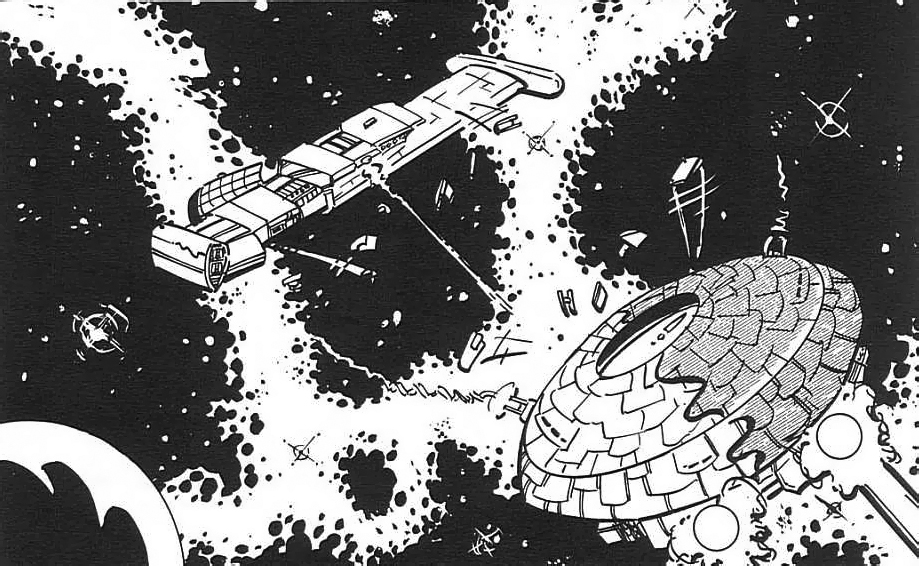
The Squibs originated on Skor II, a small, dense world located in the Squab system, just west of the Rimma Trade Route in the Outer Rim Territories. The planet boasted a diverse ecosystem, varied terrain, and abundant resources scattered across its surface. Early tribes of Squibs were thus compelled to travel from region to region in search of necessities. Accumulating material possessions became deeply ingrained in the Squib psyche, leading some tribes to establish small villages. Those who maintained their nomadic lifestyle adopted the additional role of merchants, trading foreign goods with their sedentary counterparts. Bargaining became a fundamental aspect of Squib culture.
The Squibs progressed to the point of mass production and developed a peaceful, species-wide government known as the Polyanarchy. Sometime before 3640 BBY, a Dorcin trader discovered their world. After a lively round of negotiations, the offworlder secured mineral rights to some frigid wastelands, while the Squibs gained knowledge of starship technology. Shortly after the Ruusan Reformation, the Squib species had become sufficiently integrated into the galaxy to warrant an entry in The Jedi Path, a Jedi training manual by the Jedi biologist Bowspritz. The researcher noted that Squibs had assisted him in the past, albeit at a considerable cost in credits. In marginalia added by other Jedi in one copy of the book, Obi-Wan Kenobi remarked that he considered them thieves.
The Squibs' inherent curiosity and mastery of haggling enabled them to establish a niche as interstellar garbage collectors and scavengers. While Squib settlers colonized other planets, Squib companies signed contracts to haul waste from populous worlds, and other corporations refurbished the waste for resale. Skor II evolved into a prosperous trade world, with a major population center at Metrobig City. Sometime before 20 BBY, the planet joined the Galactic Republic.
Meanwhile, the Squibs' activities brought them into direct competition with another scavenger species: the Ugors. Over time, this led to a tense antagonism, bordering on outright war. The Squibs came to view the Ugors as their hereditary enemies, and the Ugors effectively demonized the Squibs in their religion of trash worship.
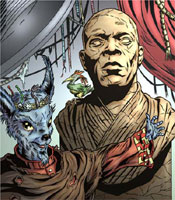
Before the events of 40 BBY, the Polyanarchy was ruled by Ebareebaveebeedee. His time as king is viewed as a period of prosperity. He initiated agreements with various factions across the galaxy, placing Squibs on large spacecraft to handle waste. While some considered them to be akin to slaves, they were permitted to retain any discarded items they found valuable. The Squib government, however, saw these workers as embedded spies, tasked with relaying the coordinates of garbage disposal sites to the Squib Reclamation Fleet.
Despite advances from the Confederacy of Independent Systems, Ebareebaveebeedee was a strong supporter of the Galactic Republic during the Separatist Crisis, stating his people were "going nowhere" and that the Jedi were "koovy." In the 15th month of 21 BBY, Separatists captured Metrobig Interplanetary Blastport. Jedi Master Mace Windu, along with Commander Cody, led Republic forces to expel the battle droids and reclaim the spaceport during the Battle of Skor II. Ebareebaveebeedee honored Windu by erecting a bronzium statue and bestowing upon him the title "Big Time Hero of Beyond-Squib Eliteness." For the remainder of the war, the Squibs' homeworld was located in uncontrolled territory. Yet, Squib scavengers continued to clean up after battles, leading the Jedi Padawan Ahsoka Tano to view them as valuable sources of information regarding Separatist movements.
Following the rise of the Galactic Empire, the Squibs faced a minor setback concerning the salvage of orbital debris. This was followed by a more significant challenge: early in the New Order, the Squibs were largely displaced by their rivals, the Ugors, as the galaxy increasingly relied on Ugor waste management services. The Ugors even obtained an exclusive Imperial license to collect Imperial waste in deep space and to accept waste from Imperial ships visiting their home star system, Paradise. Ebareebaveebeedee responded by securing permission for Squib sanitation workers to board Imperial ships, a tactic that maintained his network of informants. The Squibs were then forced to depend more heavily on their spy network; using the intelligence gathered, their ships could quickly seize as much waste as possible before the Ugors could arrive and drive them away.
After the Galactic Civil War started in 2 BBY, the Squib King mostly kept his people out of it. They traded with both the Galactic Empire and the Alliance to Restore the Republic. Both the Alliance and Imperial Intelligence attempted to track Squib ships to their enemies' bases, but the Squibs ensured their markets remained secret. The species profited from the galactic conflict by salvaging equipment from battle sites, repairing it, and selling it again. A number of military-grade Arakyd 74-Z speeder bikes were introduced to the civilian market in this way.
The Squibs reached a low point sometime between 0 and 2 ABY. Their intelligence revealed that the Ugors had acquired a gravity well projector, which they were using to organize the junk in their home system. This greater organization made the Ugor salvage fleet more efficient and attracted new customers who wanted to dump waste and find rare pieces of debris. As a result, the king reversed his previous policy of neutrality and made an agreement with a group of Rebel operatives. He would provide information on the location of an Imperial ship they sought in exchange for the projector. When the Rebels and a Squib diplomat named Spilferithimus-narlamos removed the device, the Paradise system returned to its disorganized state. Ebareebaveebeedee then declared a pact of mutual support between the Squibs and the Alliance. By 137 ABY, Skor II had come under the control of Sith Lord Darth Krayt as part of his Galactic Empire.
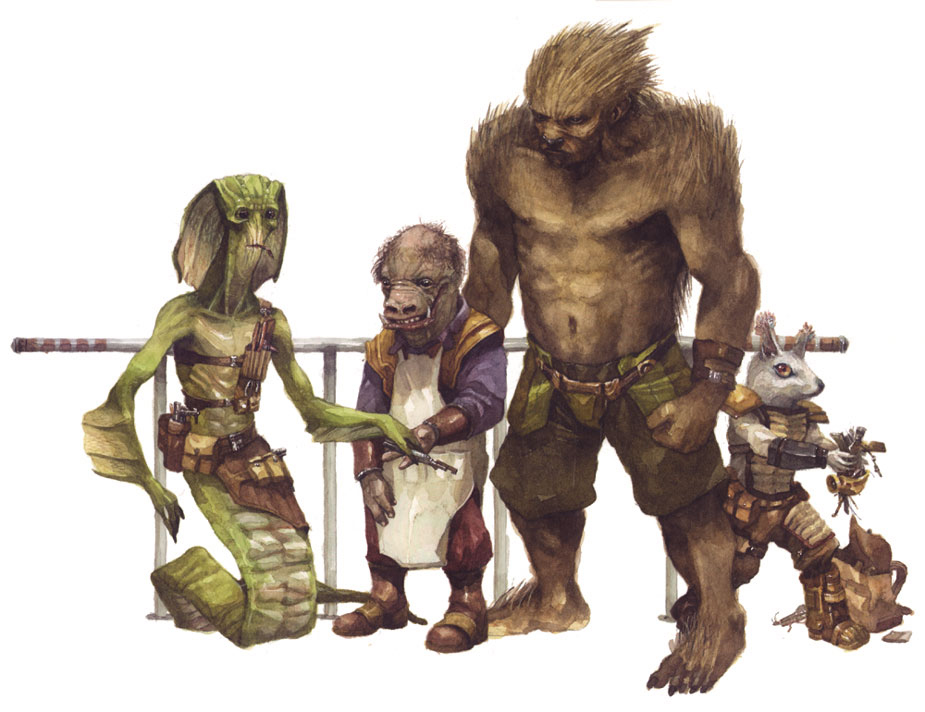
Although some Squibs held ordinary jobs, such as flying air taxis on Coruscant, they were most commonly found wherever there was waste. Squib sanitation workers were hired by capital ships to manage onboard waste. A clear sign of Squibs being present was that discarded trash had been stripped of any potentially valuable components. Many galactic citizens began to see the small beings as merely laborers, a view that persisted into the era of the New Jedi Order. Squib waste workers, particularly during the Empire's reign, maintained a low profile and avoided contact with their employers. Others broke their contracts because of poor treatment. Rebel Alliance operatives sought out unhappy Squibs to gain useful logistical and operational information about Imperial ships. In 3 ABY, Alliance operatives working undercover were hired by the Squib Jeremos to work on the Star Destroyer Indomitable. They used their position to access sensitive areas of the ship and advance their mission. Squib salvagers sometimes hired non-Squibs to assist them in their work.
Some Squibs were fringers, scavenging on a single planet. For example, Squeerie led a team on Almas around 32 BBY and helped a group of agents working for the Human Jedi Master Lanius Qel-Bertuk locate his lost Wookiee counterpart, Kirlocca. After Order 66 at the end of the Clone Wars, members of Squeerie's group, led by Jiminaldo-mabbramsti, also known as Jimi, encountered agents of Jedi Master Denia while fighting with a group of Ugors over the salvage of a damaged droid in the ruins of Almas Academy.
The offworlders helped to settle the dispute.
Soon after, however, a group of Dark Lizards attacked everyone. Maja was a Squib who bought the salvage rights to a waste field on the third moon of Kothlis around 4 ABY. He was trapped in a Plexus Droid Vessel and soon found himself facing a group of adventurers who needed information from the vehicle. Being a good Squib trader, Maja gave up his would-be personal craft for the right price.
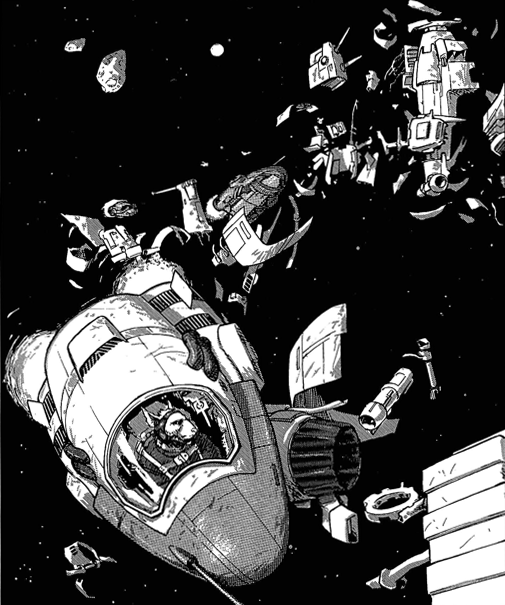
Other Squibs chose to live as spacers. Some worked as scouts, passively scanning deep space for interesting junk, while others tracked ships to reclaim their waste dumps. Squib ships joined the wreckage of the Hoth asteroid field while trying to salvage the remains of the Mugaari pirate Icanis Tsur 's ship.
During the Galactic Civil War, a Squib spacer was present at the Maze bar when a group of would-be Rebel Alliance operatives fled Imperial stormtroopers.
In 13 ABY, the crew of a Squib prospector vessel was detained on the Quarantine Enforcement Cruiser Lycoming. In Piringiisi on Sullust, a Squib tourist survived a dianoga attack, alerting the authorities to the presence of the predator in the mud pits there. Around 24 ABY, a Squib salvage scow recovered artifacts from the ruins of the planet Byss, including a copy of the book The Jedi Path.
Squib traders traveled to even the most remote and secretive locations to sell reconditioned goods, which caused many top-secret facilities to completely rethink their security protocols when such unexpected visitors arrived. They were one of the few species from the known galaxy to have a significant presence in the Unknown Regions, and their language was one of the many lingua franca used in that region of space. In fact, one Squib scout made first contact for the galactic scavengers with a pair of explorers of the Chiss species. The species was so well established that Squibs were among the many targets in the holographic shooting range of Almas Academy. A Squib named Kwilper traveled from spaceport to spaceport selling art he had made from salvaged junk. In 3 ABY, a Squib named Veeter found himself stranded on Dalicron-4, desperate to repair his ship and return to his nomadic life. Occasionally, traveling Squib traders obtained goods whose value even they couldn't imagine. One found himself at the center of a bidding war between parties interested in a data storage unit containing an important decryption program.
Squibs opened second-hand shops in spaceport towns. Around 0 BBY, Macemillian-winduarté helped run Jawa Traders, a droid shop on the planet Tatooine. The gray-furred Squib had to deal with thugs hired by Jabba the Hutt to collect protection money from him. A group of spacers once helped him resist such a shakedown, and Macemillian-winduarté loaned the offworlders a landspeeder in gratitude. In 9 ABY, Arrejis Mellaha ran Serooin's Gear on the smugglers' world Betha II. In 13 ABY, Sheebareevadee operated Sheebareevadee's Emporium of Interstellar Goods on the planet Gamorr. Other Squib traders included one on the planet Asation and another on the planet Kabal.
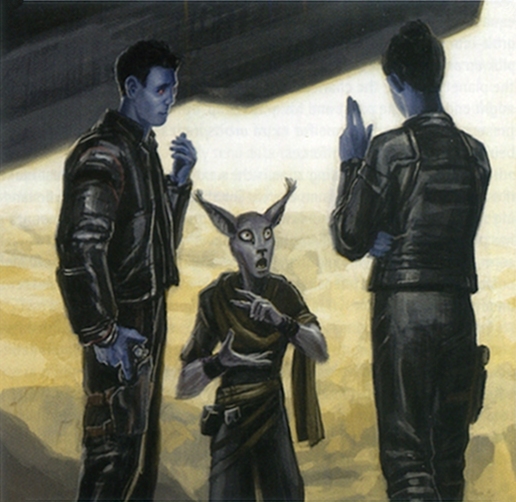
Other Squibs became scoundrels. Their ranks included petty thieves, such as the pickpocket-turned-Rebel Smileredon-Verdont, forgers, like the two Squibs employed by the Sljee Jeseej on Coruscant, infochants, such as Blasnic of the Burnout space station's, and full-fledged crime lords, such as Slythor, who controlled salvage operations on the junk planet Korad. Four Squib thieves were tasked by the Human Rebel operative Quip Fargil on the planet Sriluur to steal components from an Interdictor cruiser to help upgrade the hyperdrive of the freighter Millennium Falcon.
The family unit of Emala, Grees, and Sligh were a trio of scoundrels who had dealings with the Human Solo family over the years. In 8 ABY, they were working as information brokers, selling data to the New Republic. They partnered with the Solos to acquire the painting Killik Twilight, which contained hidden data important to the New Republic. They later worked with members of the criminal organization known as the Invisible Shell, but when their patsy, the Jenet Ludlo Lebauer, discovered their scheme, he froze Grees in carbonite. The Squibs tricked the Solos into helping them rescue their companion on the casino planet Pavo Prime. After the Yuuzhan Vong War, the three were still selling artwork, and their organization had expanded to include Emala's children, Krafte and Seneki, as well as Squib assassins. By 44 ABY, the trio had found work with the Human Admiral Natasi Daala, the former Chief of State of the Galactic Alliance, who sent them to become test subjects for Moff Tol Getelles, who was conducting trials of a serum, derived from a creature known as the droch, that could restore youth to its taker. During their time with the Human officer, the information brokers became familiar with Getelles' hidden laboratory complex, which was disguised as a mine called the Moon Maiden on the mining moon Hagamoor 3. There they learned of Daala's plan to remove Head of State Jagged Fel of the Imperial Remnant from power. The Squibs' involvement was revealed when they crossed paths with the Solos later that year. In exchange for information about the experiments, the Solos granted the Squibs safe passage to Coruscant. On the galactic capital, the Squibs handed over a stolen vial of the serum to Fel under threat of arrest. They then took a job for the Human Lydea Pagorski, an Imperial Lieutenant who served as Daala's campaign manager in a race against Fel. The Squibs led Pagorski to Getelles' abandoned Moon Maiden base, where she established a campaign headquarters. Things went wrong when Pagorski revealed herself to be a monstrous dark side entity known as Abeloth, whose only goal was to draw a constant stream of victims into the base to feed off their fear and suffering. Meanwhile, the Mandalorian bounty hunter Boba Fett tracked the Squibs to the base in his search for a pair of scientists who had created a nanokiller tailored to his genetic makeup. While three other Squibs remained with Pagorski and enslaved workers in a fire bulkhead, Sligh fled into hiding upon Fett's arrival. He was later discovered by the former Jedi Knight Tahiri Veila, who used the Force to interrogate him and learned of the Squibs' dealings with Pagorski. Soon, the Squibs in the fire bulkhead were attacked by the Human Jedi and the Mandalorian bounty hunter, whom she had rescued. The pair of Humans then defeated Abeloth in the chamber beyond.
Some Squibs had a talent for the Force. Some Force-sensitive members of the species were unaware of their abilities and remained on Skor II, while others were trained as Jedi. A popular series of children's stories from the time of the Republic focused on a roguish Squib Jedi who was rumored to be based on a real person. The series consisted of several volumes, with the third titled Busteromuchmacho and the Vermillion Shadow. Years later, in 35 ABY, a Squib Jedi was training at the Jedi Academy on the planet Ossus. A small number of Squib nobles traveled the spacelanes.
Over 220 years before the Battle of Yavin, a Squib vessel crashed on the planet Holador. The survivors sent out a distress signal and waited to be rescued, but no one came. When their equipment failed, they were forced to return to a primitive way of life. Over seven generations, the Squibs began to worship their comm relay as a Holy Icon, hoping that offworlders would one day return them to the stars. A Twi'lek bounty hunter named Kelyan tried to convince the village that a group of visiting adventurers was dangerous.
However, the village elder, Alexem, was convinced that she was trying to manipulate the tribe.

The introduction of the Squibs to the Star Wars universe occurred in Brad Freeman's adventure, Scavenger Hunt, a product of West End Games published back in 1989. This narrative involves a group of Rebel protagonists pursuing the Imperial vessel Elusive, with the Squib king, Ebareebaveebeedee, and his associates possessing the only knowledge of its whereabouts. Subsequently, in that same year, Troy Denning expanded upon the species' characteristics in Galaxy Guide 4: Alien Races. According to this book, they were conceived as a source of lighthearted humor, differing from Ewoks in their ability to be found throughout the galaxy and engage with other characters on a more equal technological footing. West End Games portrayed Squibs as possessing greater dexterity than most species, but with limitations in areas such as intelligence, strength, and technical skill. The Wizards of the Coast rendition of the Squibs, presented in both Alien Anthology (2001) and Ultimate Alien Anthology (2003), also emphasizes their high agility, while also assigning them below-average common sense and observational skills. When the Wizards' system transitioned to the Saga edition, Squibs were penalized in strength but gained a bonus to their agility. Furthermore, they acquired the unique ability to reattempt technological manipulations. Several publications offer summaries of these books, without contributing any novel details about the species. The preceding details are predicated on the assumption that encounters with Squibs in role-playing scenarios are geared towards maximizing player character gains. However, alternative scenarios exist. For example, the 1996 adventure titled New Recruits and Rebel Guns presents the possibility of a Rebel Alliance character meeting a Squib spacer in a bar called the Maze, but this encounter is not essential to the story's progression. In the 2005 adventure Strike III, Alexem, the Squib leader, and his tribe might choose to attack the player characters if they are not convinced of the characters' peaceful intentions. Lastly, in 2008's Echoes of the Jedi, player characters have the option to disregard the conflict between Jiminaldo-mabbramsti and his Ugor rivals, but doing so results in a reduced reward.
Denning has prominently featured the Squib characters Emala, Grees, and Sligh in a total of five novels and one short story. This trio also made an appearance in Fate of the Jedi: Ascension, authored by Christie Golden. Pablo Hidalgo, another Star Wars author, has publicly expressed his fondness for Squibs on his blog. In a Star Wars: The Roleplaying Game campaign that Hidalgo oversaw, one of his players played a Squib character named Smileredon-Verdonté. This character, with a slightly altered name, was later included in Heroes & Rogues (1995) and became a recurring character in the Rookies webcomics. Hidalgo's account of the Battle of Skor II clarifies the reason why a Squib character in Galaxy Guide 7: Mos Eisley shares the name "Mace Windu" with the Jedi character portrayed by Samuel L. Jackson in the prequel films: the name, along with variations of it, has been present in George Lucas's notes and drafts for the Star Wars saga since 1973. According to Hidalgo's article, the Squib (whose complete name is Macemillian-winduarté) was simply named in honor of the Jedi hero who saved his home planet. While Denning's Squib characters generally speak standard Basic, Hidalgo's characters communicate in what he refers to as "Squibberish," a garbled, imprecise form of Basic interspersed with Squibbian words like "koovy."
The existence of the species has presented certain inconsistencies within Star Wars literature. For instance, the term "Squib" is incorrectly spelled "Squibb" in the Star Wars Adventure Journal articles "Murder in Slushtime" and "The Gree Enclave." Furthermore, the novels Shield of Lies and Shatterpoint render the species' name in lowercase letters. The Official Star Wars Fact File 138 asserts that the Squibs originate from the Paradise system, sharing it with their adversaries, the Ugors. However, more recent sources, such as The Complete Star Wars Encyclopedia, contradict this statement, suggesting that the Fact File contains inaccurate information. "HoloNet Waystation," an unofficial roleplaying adventure featured in Challenge 74, implies that Tatooine was too isolated for Squibs to visit. This assertion clashes with the established presence of Macemillian-winduarté, a trader residing on Tatooine, as depicted in Galaxy Guide 7: Mos Eisley and the short story "Spare Parts." The relationship between the Squib species and the Squib battering ram remains unclear across various sources. Galladinium's Fantastic Technology includes the battering ram in its description of the Squib species, presenting it as an item accessible to members of the species. Conversely, in The Bounty Hunter Code: From the Files of Boba Fett, the in-universe narrator, the bounty hunter Boba Fett, clarifies that the device was named after the Squibs, not designed by them, due to their knack for infiltrating restricted areas.